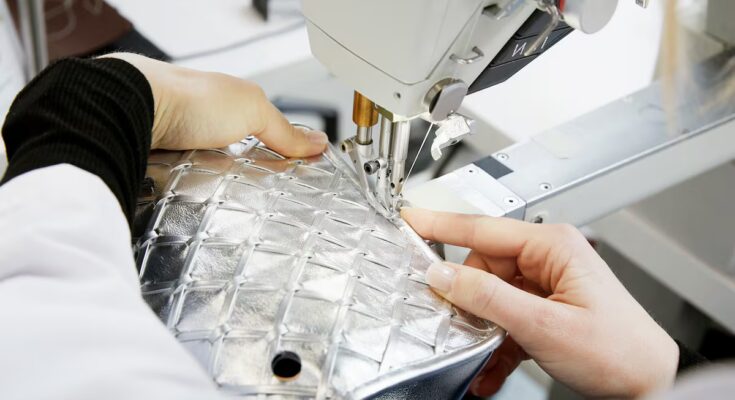With an unexpected twist, Chanel lets four journalists enter the ateliers of Verneuil-en-Halatte for the first time, 50 kilometers north of Paris, the place where what remains the most desired object of contemporary luxury is produced: the 2.55 bag, created by Coco Chanel in 1955, and the 11.12, the version modernized in 1983 by Karl Lagerfeld, also known as “the classic”. Why do they do it? And why now? There may be more geopolitics in a luxury stock exchange than in the United Nations General Assembly. Let’s see: a Chinese campaign on TikTok showed several operators ensuring that the great icons of classic luxury were mass-produced from their factories, a reputational crisis for some European houses, a sudden slowdown in the consumption of luxury goods in China and an unstoppable increase in the prices of both accessories. Everything can explain why Chanel decided to tell the story of its myths.
According to the newspaper Le Monde“breaking down the entire production chain, where most of the stages are carried out manually, is an ingenious way to justify the increase in prices of the last decade”. In 2006 an 11.12 bag cost 1,500 euros; in 2019, 4,800 euros, and currently its price is around 10,300 euros. THE house claims that these increases reflect the high costs of raw materials and are the result of its policy of standardizing prices around the world (there was a time when it was better to buy them in Europe). Bruno Pavlovsky, president of Chanel and, since the death of Karl Lagerfeld, face of the French house in front of the press, does not avoid the issue of rising prices: “It’s what luxury is worth. Chanel is in good economic health because it manufactures products that require exceptional knowledge and materials. I think it’s important to show how we work, to show why expensive things are expensive. If we don’t do this, people will never know.”

The Verneuil-en-Halatte laboratories, inaugurated in 2021, look like a large Tetris, 25,000 square meters of concrete in the middle of the Halatte forest. As often happens in other factories, there is not a single clue that makes the visitor think that luxury here is made with one’s own hands. Electricity production is partly provided by photovoltaic panels and natural light abounds in most rooms, especially in the laboratories on the second floor, facing north, where 300 artisans work. They are experts in some of the 180 operations required by the two bestsellers of the house, around 30 people are needed to finish each accessory: prototypes, cutters, assemblers… To be able to intervene at any stage of the process, each craftsman must be trained in the laboratories for four or five years, regardless of their previous skills. “The idea is that they can finally make a bag from A to Z, but it’s a gradual learning process,” they say in the workshops. They are the guardians of savoir faire of Chanel to produce these models which are now absolutely Made in Franceas they assure us in Verneuil. We will see artisans in their 30s and 40s housetrue experts in treating leather, in weaving or in turning the bag like a jacket to finish it inside out, just as Coco Chanel had decided it should be done. When Pavlovsky is asked why the fascination with the 2.55 never ends, he replies without thinking: “Because it’s not a leatherworker’s bag, it’s a woman’s bag. stylist”.
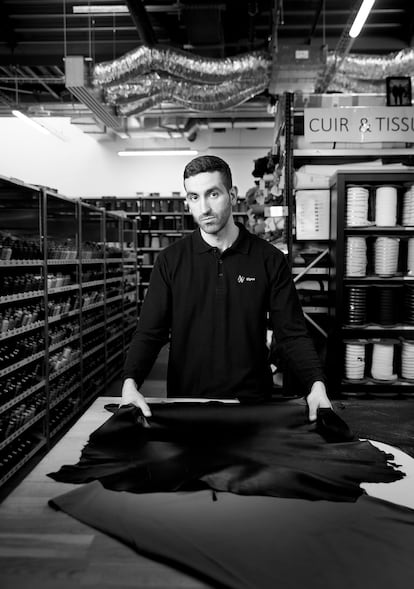
At the entrance, a large room recalls the legacy of the maison and the life of its founder, who already around 1920 had created a shoulder bag that left women’s hands free. In 1955 it presented the legendary 2.55 model which was then sold for the equivalent of 200 euros today. It had a chain that served as a shoulder strap, seven pockets, patterned quilted (padded) equestrian-inspired and there was no sign of a logo. In 1983, Karl Lagerfeld gave it a twist: he woven a strip of leather into the chain, added a “mysterious” front pocket and placed the house’s emblematic double C on the clasp. This transformation took place in these laboratories, which since 1990 have been located in this region conveniently close to Paris. The same proportions and technical processes have been maintained ever since.
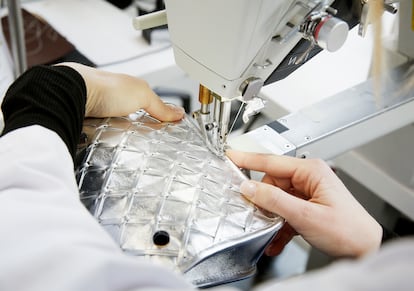
The Verneuil factory has a warehouse with more than 900 leather and fabric references and 1,100 varieties of threads and hardware. In its commitment to transparency, Chanel claims that all materials come from “traceable supply chains.” Its suppliers are in France, Italy and Spain. The artisans control the flexibility and thickness of the leather and the levels of shine. “Each bag is unique in terms of raw materials,” they explain. 20 pieces of leather are needed per bag, and the leftovers are recycled to produce salpa, a regenerated leather fiber material used in the prototypes.
The cutter we see in action has been in the house for 23 years and shows us that the cut must be “clean”. To optimize the skin, you almost have to set up a Tetris before a digital cutter selects the best area to make the cut with a significant amount of noise.
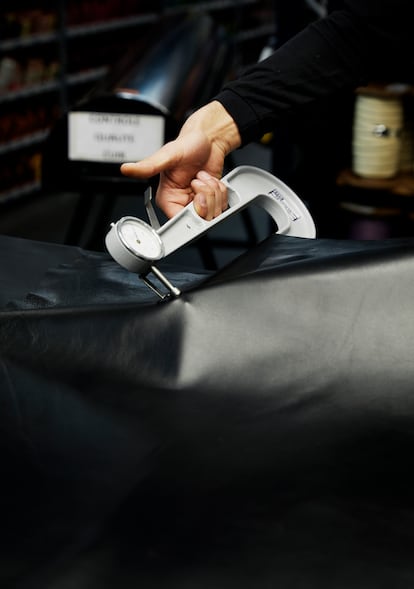
In another room there is a screen that projects the fashion film where Penélope Cruz and Brad Pitt pay homage to the film A man and a woman (1966), by Claude Lelouch, moving on to the classic 11.12. When there is a fashion show, the artisans gather in front of this screen to check which of their creations has been chosen to go out on the catwalk and into the world.
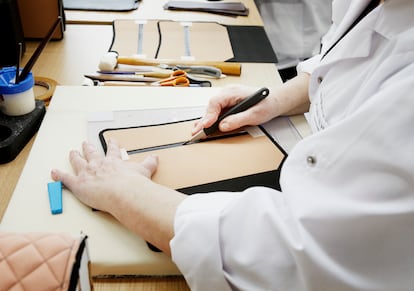
In the bag preparation laboratory of 11.12 everyone is very busy with their specific operations. A craftsman finishes the quilting of a bag, positions the front pocket and positions the closure. The next step is a rigorous inspection of every seam and every segment. In the assembly area, the volume of the pockets is flattened with the hammer in the hand and the leather is shaped with the fingers. One of the most difficult steps is turning the bag inside out to sew it inside out. “You have to do it very quickly and avoid the material being damaged in the process. The craftsman responsible has been working at Chanel for more than 40 years. Pavlovsky says that until the last moment, when you examine the bag upside down, you don’t know if everything is OK. “It’s probably the only bag in the current luxury market with such a complication, and it comes from Miss Chanel and her way of designing, as beautiful on the outside as on the inside. It has nothing to do with him savoir faire from other brands or with what is created in the laboratories in Italy, it is a unique way of working”.
Hammer ready, a craftsman recovers the shape of the bag and with another tool irons the seams. Then check that they are all aligned and reinforce the corners.
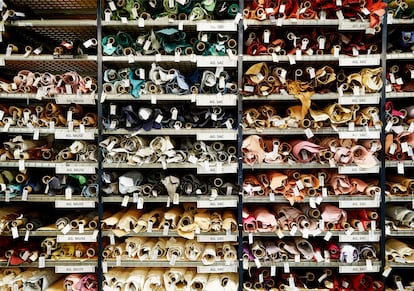
On another machine, Sylvie Dupont dedicated herself to creating the chain and leather weave, emblematic of the Chanel shoulder strap. He has been in the house for 39 years. “Chains are my passion and pride. It’s important to maintain tension and the correct position of your hands and fingers. It’s harder than it sounds, but very relaxing,” he says. Once braided, the ends of the chain are sewn by hand. “Three or four millimeters of separation between the seams, no more, no less,” he specifies. The seam is finished three times and fixed with glue. “There has to be a sturdy chain that can hold up,” he concludes. This is then followed by several quality control operations in which each bag is checked in detail. This is followed by weight and temperature resistance tests in which a robot replicates the use of the bag designed to last multiple lifetimes and be the object of heirlooms and family possessions.
Bruno Pavlovsky explains that, despite strict quality controls, no bag that leaves the factory is the same as another. “It’s not about copying and pasting everything, it would be very easy. If you look closely at each of our bags, including the most iconic ones, they are slightly different from each other, simply because they are handmade and that involves an emotional part. To illustrate this, Pavlovsky says that for the show (we visited the factory the day before) they work with 70 models. “Maybe half of them are wearing the classic one (11.12). They don’t have to do it, we don’t put pressure on them, but they keep it in mind. tweedin black, in various colors, and they don’t carry, for example, the Chanel 25, which is the new bag, but the classic one from 1983 because it is iconic, it has something special in its style and its meaning. I think it’s the best asset we have at Chanel and will be for a long time. Other brands fight their whole lives to have an icon. Not us. We are lucky that this bag arrived home before us.”
